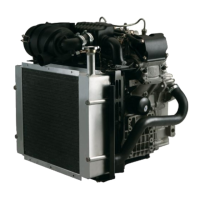
Do you have a question about the Kipor KM2V80 and is the answer not in the manual?
Overview of the Kipor KM2V80 series diesel engine, its features, and benefits.
Explanation of the model designation and its components.
Diagrams showing external views and identification of engine parts.
Table detailing key technical specifications of the KM2V80 diesel engine.
Key parameters for engine adjustment, including valve timing and pressures.
Specifications for tightening torque values of various engine bolts and nuts.
Table listing standard and fitting clearances for engine components.
Guidelines for performing daily checks and understanding periodic maintenance schedules.
Detailed procedures for periodic checks at different service intervals.
Specific maintenance tasks recommended after the initial 50 hours of operation.
Maintenance tasks to be performed every 250 hours of engine operation.
Maintenance tasks to be performed every 500 hours of engine operation.
Maintenance tasks to be performed every 1000 hours of engine operation.
Maintenance tasks to be performed every 2000 hours of engine running.
General guidelines and preparation steps for engine disassembly.
Steps for removing the muffler assembly.
Steps for removing the air filter assembly.
Steps for removing the cooling system tank components.
Steps for removing fan assembly components.
Steps for removing the air intake ducting components.
Steps for removing the air intake pressurizer tank.
Steps for removing cooling system pipework.
Steps for removing thermostat and related cooling system parts.
Steps for removing the starter motor and its mounting.
Steps for removing cylinder head components.
Steps for removing fuel injection lines and injectors.
Steps for removing fuel system control components.
Steps for removing the flywheel and associated rotor parts.
Steps for removing the engine crankcase cover.
Steps for removing camshaft and valve tappet components.
Steps for removing piston and connecting rod assemblies.
Steps for removing the crankshaft.
General guidelines and preparation steps for engine reassembly.
Checks and maintenance for the cylinder head, valves, and seats.
Inspection procedures for camshaft journals, height, and clearances.
Inspection of pistons, rings, pins, and their clearances.
Inspection of crankshaft journals, connecting rod, and main bearings.
Checks and clearance measurements for the oil pump.
Checking thermostat opening temperature and radiator water leakage.
Procedures for checking fuel injection pressure, spray, and sealing.
Checking the starter motor for electrical conductivity and operation.
Testing the function of the electromagnetic switch.
Steps for disassembling the starter motor.
Inspection and maintenance of starter motor components like commutator and brushes.
Checking the resistance and condition of the glow plug.
Diagnosing and resolving issues indicated by alarm and indicator lamps.
Troubleshooting common problems related to engine starting.
Identifying causes and remedies for black, blue, and white exhaust smoke.
Diagnosing reasons for reduced engine power and their solutions.
Troubleshooting erratic engine performance and unstable running.
Identifying causes and solutions for engine overheating.
Troubleshooting reasons for the engine stopping unexpectedly.
Diagnosing and resolving abnormal noises occurring during engine operation.
Essential checks and preparation steps before initial engine operation.
Procedure for checking and refilling the fuel tank.
Procedure for checking and refilling the engine oil level.
Procedure for checking and refilling the cooling water.
Ensuring the governing handle operates smoothly.
Verifying the proper functioning of the engine alarm system.
